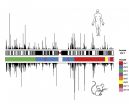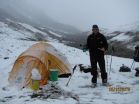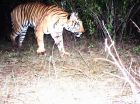(Press-News.org) Cold Spring Harbor, NY - An international team of researchers led by Professor Thomas R. Gingeras of Cold Spring Harbor Laboratory (CSHL) and Roderic Guigo (Centre For Genomic Regulation, Barcelona) has identified some 6600 genes whose level of expression varies within a comparatively restricted range in humans and mice.
This constraint in expression, they found, is unrelated to the degree of similarity of their gene sequences. The 6600 genes represent about one-third of the total set of genes that are typically active in cells across tissues in both species, irrespective of cell type. The study, say the researchers, provides new information that will continue to assist in making the mouse an excellent model organism in which to study human diseases and biology.
"We found that evolution has placed remarkably narrow constraint on the expression levels of these 6600 genes, and we believe this reflects the importance of these particular genes for operation of all cells in all tissues in the two species," said Gingeras, who is the Head of Functional Genomics at CSHL. "What evolution is telling us is that these genes need to limit the variability of their expression irrespective of the cell type in which they are expressed -- increased variation would be highly detrimental to basic cellular housekeeping. Cells need these genes to behave within a relatively narrow range in order to work properly."
The 6600 genes identified by the team have evolved in mice and people to show expression that varies over about a hundred-fold range, whether, for example, in breast tissue or lung tissue; whether in an epithelial cell or a nerve cell. This is compared to the remaining two-thirds of expressed genes, which are capable of varying their expression over a 100,000-fold range.
Gingeras and collaborators additionally found that when six very different animal species are compared, ranging from chickens to humans, there are still a set of 2500 genes they share in common whose expression is sharply constrained in the same narrow range. This shows that this regulatory mechanism is evolutionarily very old and thus important, the scientists say.
These results, published on biorxiv.org, are part of a large body of research reported in several scientific journals, representing the latest work of the Mouse ENCODE project. This international consortium, of which Gingeras is a principal invesitgator, also reports shared findings today in four papers in Nature. The work examines the genetic and biochemical programs involved in regulating mouse and human genomes.
At the same time, the consortium has found powerful clues to why certain processes and systems in the mouse - such as the immune system, metabolism and stress response - are so different from those in people. Building on years of mouse and gene regulation studies, they have developed a resource that can help scientists better understand how both the similarities and differences between mice and humans are written in their genomes.
The results, taken as a whole, may offer insights into gene regulation and other systems important to mammalian biology. They also provide new information to determine when and in what cell types and tissues the mouse is an appropriate model to study human biology and disease, and may help to explain some of its limitations. That, indeed, is among the implications of the work reported by Gingeras and colleagues in their new paper.
All of the newly published research results are from the mouse ENCODE project, which is an extension of the human ENCODE (ENCyclopedia Of DNA Elements) program. ENCODE is building a comprehensive catalog of functional elements in the human genome. Such elements include genes that code for proteins, non-protein-coding genes and regulatory elements that control which and when genes are turned on or off. ENCODE and mouseENCODE projects are supported by the National Human Genome Research Institute (NHGRI), part of National Institutes of Health (NIH).
"The mouse has long been a mainstay of biological research models," said NHGRI Director Eric Green, M.D., Ph.D. "These results provide a wealth of information about how the mouse genome works, and a foundation on which scientists can build to further understand both mouse and human biology. The collection of mouse ENCODE data is a tremendously useful resource for the research community."
More than a dozen related studies stemming from the MouseENCODE data also appear or will appear in journals such as Genome Research, Genome Biology, Nature Communications, and Blood.
INFORMATION:
The work described in this release was supported by the National Human Genome Research Institute (NHGRI); the Spanish Plan Nacional; the ERC; LaCaixa; and the EU-FP7 quantomics project.
"Enhanced Transcriptome Maps from Multiple Mouse tissues Reveal Evolutionary Constraint in Gene Expression for Thousands of Genes" can be obtained at bioarxiv.org: http://www.biorxiv.org/content/early/2014/10/30/010884. The authors are: Dmitri Pervouchine, Sarah Djebali, Alessandra Breschi, Carrie A Davis, Pablo Prieto Barja, Alex Dobin, Andrea Tanzer, Julien Lagarde, Chris Zaleski, Lei-Hoon See, Meagan Fastuca, Jorg Drenkow, Huaien Wang, Giovanni Bussotti, Baikang Pei, Suganthi Balasubramanian, Jean Monlong, Arif Harmanci, Mark Gerstein, Michael A Beer, Cedric Notredame, Roderic Guigo, and Thomas R Gingeras. Four papers produced collectively by the Mouse ENCODE Consortium appear on November 19, 2014 in Nature. These papers can be obtained at: http://www.nature.com/nature/index.html
About Cold Spring Harbor Laboratory
Celebrating its 125th anniversary in 2015, Cold Spring Harbor Laboratory (CSHL) has shaped contemporary biomedical research and education with programs in cancer, neuroscience, plant biology and quantitative biology. Home to 8 Nobel Prize winners, the private, non-profit Laboratory is more than 600 researchers and technicians strong. The Meetings & Courses program hosts more than 12,000 scientists from around the world each year on its campuses in Long Island and in Suzhou, China. The Laboratory's education arm also includes an academic publishing house, a graduate school and programs for middle and high school students and teachers. For more information, visit http://www.cshl.edu
This news release is available in Spanish. A group of international researchers has just discovered the keys to explaining why certain processes and systems in mice, like the immune system, metabolism and stress response, are so different to those in humans. The scientists have detailed the functional parts of the mouse genome and have compared them with those in humans. A whole set of data has come out of this - which is now to available to the scientific community - which will be significant for research into mammalian biology as well as the study of human illness ...
Washington, DC--The Endocrine Society today issued a Clinical Practice Guideline (CPG) for the diagnosis and treatment of Paget's disease of the bone, a condition where one or more bones in the body become oversized and weak.
The CPG, entitled "Paget's Disease of Bone: An Endocrine Society Clinical Practice Guideline," will appear in the December 2014 issue of the Journal of Clinical Endocrinology and Metabolism (JCEM), a publication of the Endocrine Society.
As part of its normal processes, the body breaks down old bone tissue and replaces it with new bone. When someone ...
CINCINNATI - Conclusive data show that hydroxyurea therapy offers safe and effective disease management of sickle cell anemia (SCA) and reduces the risk of stroke, prompting early termination by the National Heart Lung and Blood Institute (NHLBI) of a key clinical trial studying the drug's efficacy.
NHLBI officials issued the announcement today, about one year before the study was originally scheduled to end. Going by the title TWiTCH (TCD With Transfusions Changing to Hydroxyurea), the Phase III randomized clinical trial at 25 medical centers in the U.S. and Canada compared ...
CHAMPAIGN, Ill. -- Youth who enter puberty ahead of their peers are at heightened risk of depression, although the disease develops differently in girls than in boys, a new study suggests.
Early maturation triggers an array of psychological, social-behavioral and interpersonal difficulties that predict elevated levels of depression in boys and girls several years later, according to research by led by psychology professor Karen D. Rudolph at the University of Illinois.
Rudolph and her colleagues measured pubertal timing and tracked levels of depression among more than ...
The intense farming practices of the "Green Revolution" are powerful enough to alter Earth's atmosphere at an ever-increasing rate, boosting the seasonal amplitude in atmospheric carbon dioxide to about 15 percent during the last five decades.
That's the key finding of a new atmospheric model that estimates that on average, the amplitude of the seasonal oscillation of carbon dioxide in the atmosphere is increasing at the rate of 0.3 percent every year.
A report on the results of the model, called VEGAS, is published today in the journal Nature.
"What we are seeing ...
Each year in the Northern Hemisphere, levels of atmospheric carbon dioxide drop in the summer as plants "inhale," then climb again as they exhale after the growing season.
During the last 50 years, the size of this seasonal swing has increased by as much as half, for reasons that aren't fully understood.
Now a team of researchers has shown that agricultural production may generate up to a quarter of the increase in this seasonal carbon cycle, with corn playing a leading role.
"This study shows the power of modeling and data mining in addressing potential sources ...
The U.S. Department of Health and Human Services today issued a Notice of Proposed Rulemaking (NPRM), which proposes regulations to implement reporting requirements for clinical trials that are subject to Title VIII of the Food and Drug Administration Amendments Act of 2007 (FDAAA). The proposed rule clarifies requirements to clinical researchers for registering clinical trials and submitting summary trial results information to ClinicalTrials.gov, a publicly accessible database operated by the National Library of Medicine, part of the National Institutes of Health. A ...
Geologists in Syracuse University's College of Arts and Sciences have recently figured out what has caused the Alaska Range to form the way it has and why the range boasts such an enigmatic topographic signature. The narrow mountain range is home to some of the world's most dramatic topography, including 20,320-foot Mount McKinley, North America's highest mountain.
Professor Paul Fitzgerald and a team of students and fellow scientists have been studying the Alaska Range along the Denali fault. They think they know why the fault is located where it is and what accounts ...
It's hard to believe, but there are similarities between bean sprouts and human cancer.
In bean sprouts, a collection of amino acids known as a protein complex allows them to grow longer in the darkness than in the light. In humans, a similar protein complex called CSN and its subunit CSN6 is now believed to be a cancer-causing gene that impacts activity of another gene (Myc) tied to tumor growth.
Somehow the same mechanisms that result in bigger bean sprouts, also cause cancer metastasis and tumor development.
A study at The University of Texas MD Anderson Cancer ...
Human-wildlife conflict resolution near protected areas critical for tiger survival
Stripe-matching software and individual histories inform decisions on handling conflict-prone big cats
NEW YORK (November 18, 2014)--Researchers with the Wildlife Conservation Society and other partners in India are using high-tech solutions to zero in on individual tigers in conflict and relocate them out of harm's way for the benefit of both tigers and people.
In recent tiger-conflict cases involving both a human fatality and the predation of livestock, both occurring near two of ...




